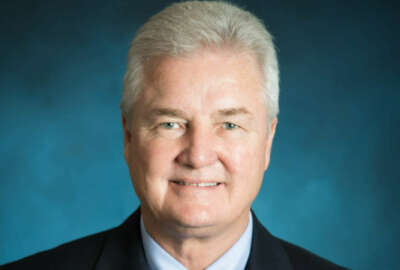
Navy benefits thanks to creative program manager’s use of small businesses
Tony Brescia won the Tibbetts Awards for his work in support of the Small Business Innovation Research and Small Business Technology Transfer programs.
Best listening experience is on Chrome, Firefox or Safari. Subscribe to Federal Drive’s daily audio interviews on Apple Podcasts or PodcastOne.
It takes a lot of commercial suppliers to keep Naval aviation going. Creative use of companies can enhance both the mission and the vendors. Senior technology program manager at the Naval Air Warfare Center Aircraft Division, Tony Brescia, has won a coveted prize from the Small Business Administration known as a Tibbetts Awards for his work in support of the Small Business Innovation Research, and the Small Business Technology Transfer programs. He joined Federal Drive with Tom Temin to discuss his work.
Interview transcript:
Tom Temin: Mr. Brescia, good to have you on.
Tony Brescia: Thank you, Tom.
Tom Temin: Tell us about your work. You’re a senior program manager and you have to do with naval warfare. Tell us more.
Tony Brescia: I’m currently within NAWCAD on the avionics engineering, science and technology domain lead, which covers as part of the avionics engineering group is avionics, sensors and electronic warfare. So these are all of the sub components that go on military aircraft supporting both naval aviation, which is both Navy and Marine Corps aircraft.
Tom Temin: And you also support both manned and unmanned aircraft.
Tony Brescia: Yes, that’s correct. Within the department, it’s all the sensors that are on the small unmanned air systems. We also do unmanned surface vehicles, and then from manned platforms, as well.
Tom Temin: And is it primarily an acquisition job? That is to say the Navy has a requirement for some piece of avionics or sensor electronics and then you have to source it?
Tony Brescia: Well, from the science and technology perspective, it’s not necessarily the acquisition that’s done on the NAVAIR side of the house, which are the program offices like the various PNAs within the organization of science and technology is mainly working with like ONR, DARPA, SOCOM, the warfighter, and looking at what new technologies are to bring the concepts to fruition that are then picked up by the program offices.
Tom Temin: Okay, so you’re a program office. So you’re the one that helps bring those developments to fruition.
Tony Brescia: Not necessarily. The program office, there isn’t a Science and Technology Program Office per se. The way the SBIR and STTR program works is that you have engineers and scientists that actually submit topics into the program that are then selected by the program offices and the command to support the work that they’re doing. So it’s filling in technology gaps within the major program offices and kind of being the incubator if you would of new concepts. So in not in all cases, as science and technology come to fruition, it answers questions and they might be yes, it works, or no, it doesn’t, or we might need to do a little bit more work. So it’s kind of a reiterative process.
Tom Temin: Well give us an example of a program of a technology that came to fruition and is in use under this methodology.
Tony Brescia: The most recent one is the system called Silver Fox, which started out in probably about 1999 or so, started out as a SBIR that was looking at the ability to do swarming algorithms. So part of the components of that was one was to work on the swarming algorithms. The second part was to come up with an autopilot to actually implement those and then the air vehicle. So all of that was coming together in the early 2000s timeframe. And from that came the Silver Fox UAS, and then there’s an autopilot that’s called Cloud Cap, which is the gold standard for auto pilots. That then was transitioned to the Navy Warfighter in Iraq and Afghanistan in 2007. And it’s still currently being flown, you know, with the US Air Force and SOCOM.
Tom Temin: So it sounds like you have even some influence and ability to affect other branches besides the Navy.
Tony Brescia: Yes, absolutely. Within the SBIR program, you actually have the cross pollination between the services. In a lot of cases, what you do is you are able to work with the other services and take on their requirements or their expectations, and try to incorporate that in so you actually allow the small business to have a larger commercialization component to their product line in their company.
Tom Temin: We’re speaking with Tony Brescia. He’s advanced program manager at the Naval Air Warfare Center Aircraft Division, and also a recipient of the SBA Tibbetts Award. And so you’ve had a lot of contact over the years. I mean, your award citation said you have done dozens I think of these types of projects. How do you stay in touch with that base of possible technology vendors such that you know where to begin to look when you have a requirement, or people are looking for some new development?
Tony Brescia: Well, one of the easiest ones today with the ability of all the search engines, you can do Google searches and looking for specific technology areas, reading scientific journals, and also previously going to conferences to listen to what is the trending technology areas, and then trying to then almost be like a cook and take all these ingredients, and bring them together to form an SBIR topic, or an STTR topic, which ties in with the academic community as well. So it is basically being a cook. There isn’t any other way to do it. Because you have to have the understanding of what the current state of the art is.
Tom Temin: Sure. Do you ever get companies come to you and say, hey, Brescia, we heard you’re a good guy to get technology from small business into the government’s hands? Do they ever reach out and maybe self discover for you?
Tony Brescia: Yes. And that’s typically approximately every year, we have various innovation conferences that are held along with the SBIR program. They’re called FST. Some of the ones, FST was also in conjunction with the Sea Air Space Expo that was held in Washington, DC. So at those, you’re able to then look at what technologies that companies are working on with other agencies. And then you look at how can I adapt that to what the current Navy and Marine Corps are looking for? So yes, you do have that and the NAVAIR, we do have an open BAA for companies to submit topics. And so you can use that venue as a way to do it. But the SBIR and STTR program or process itself is a competitive process. So even if a company comes in, it’s not a sole source, you know, for a particular technology, you have to evaluate their proposals for them to move forward.
Tom Temin: It must be satisfying, though, after the whole process is completed. And you can look up and see an aircraft or some sort of a moving object that is employing that technology that you helped connect to that platform. That must be good job satisfaction.
Tony Brescia: Yes, that is and then the flip side to that is that you now have a small business that’s actively, you know, contributing to the economy as well. And you know, not just helping out the military, but in some cases, also helping out the private sector as well.
Tom Temin: And do you ever get tempted to try out the private sector because you’ve been a public servant for I think, going on 30 years now?
Tony Brescia: Almost 40. No, I’m satisfied with what I’m doing. It’s a lot of fun on the government side to, you know, to do it, maybe when I retire, I’ll do it but no, not right now. No.
Tom Temin: Well, we’re glad you’re on our side. Tony Brescia is advanced program manager for the Naval Air Warfare Center Aircraft Division, and recipient of an SBA Tibbetts Award for his work with small business. Thanks so much for joining me.
Tony Brescia: Sure. Thank you, Tom.
Copyright © 2025 Federal News Network. All rights reserved. This website is not intended for users located within the European Economic Area.
Tom Temin is host of the Federal Drive and has been providing insight on federal technology and management issues for more than 30 years.
Follow @tteminWFED





